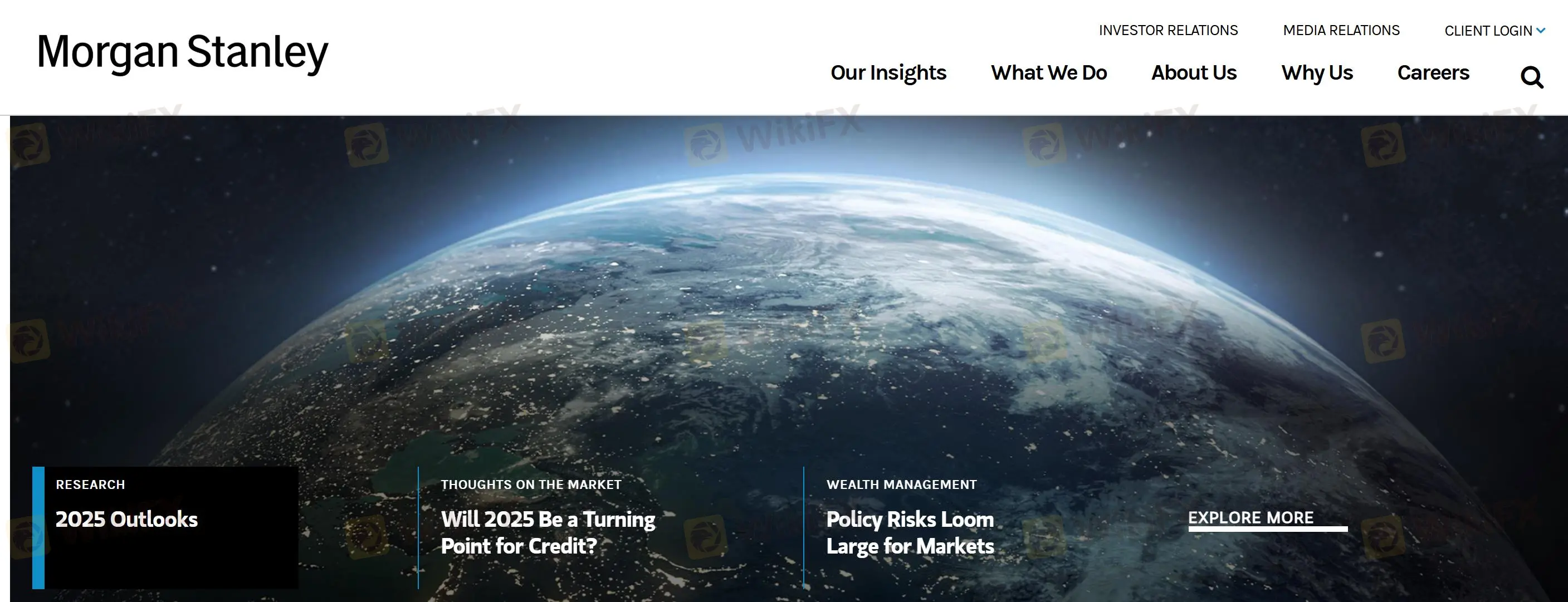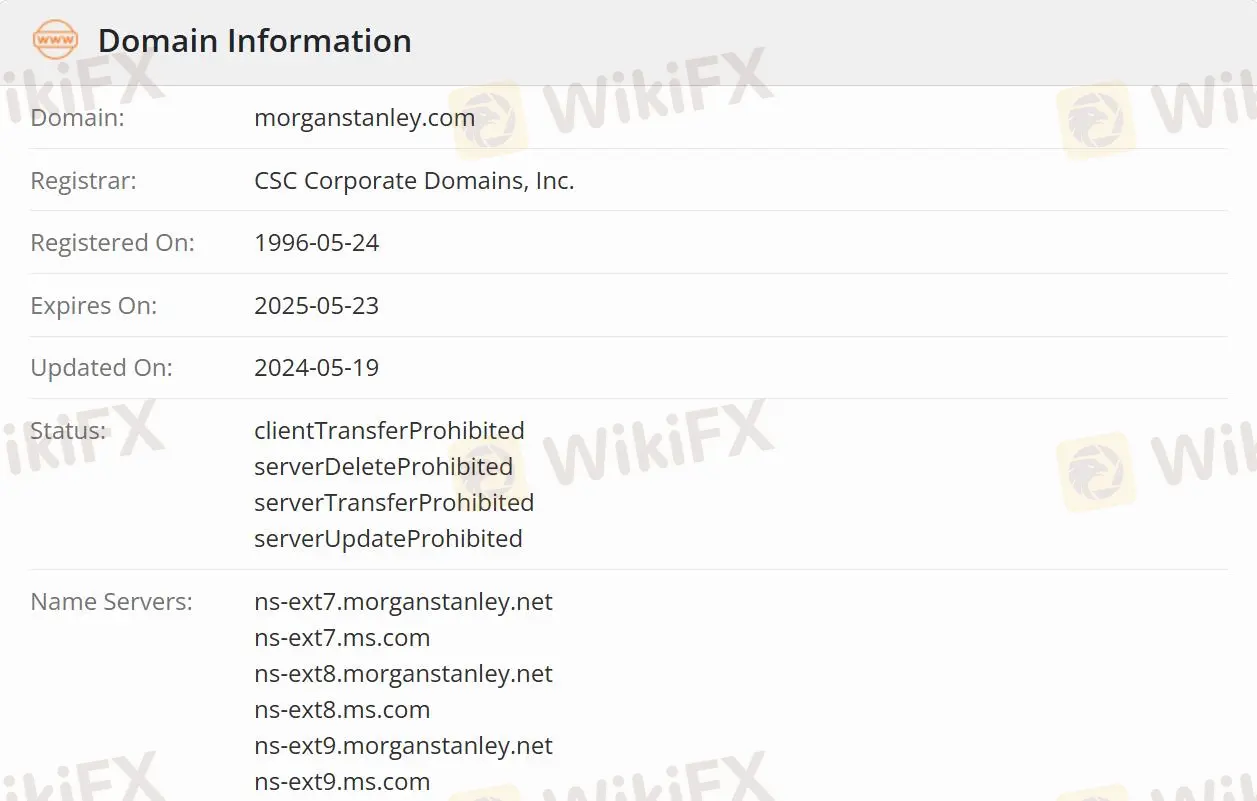기본 정보
 미국
미국점수
 미국
|
5-10년
|
미국
|
5-10년
| https://www.morganstanley.com
공식 사이트
평점 지수
영향력
AAA
영향력 지수 NO.1
 미국 9.41
미국 9.41 라이선스
라이선스라이선스 기관:Morgan Stanley Canada Limited
라이선스 번호:미공개
싱글 코어
1G
40G
1M*ADSL
 미국
미국 헝가리
헝가리 morganstanley.com
morganstanley.com 미국
미국 헝가리
헝가리




| Morgan Stanley리뷰 요약 | |
| 설립일 | 1996-05-24 |
| 등록 국가/지역 | 미국 |
| 규제 | 규제됨 |
| 서비스 | 재무 관리, 투자은행 및 자본시장, 판매 및 거래, 연구, 투자 관리, Morgan Stanley at Work, 지속 가능한 투자 및 포용적 벤처 그룹 |
| 고객 지원 | 소셜 미디어: LinkedIn, Instagram, Twitter, Facebook, YouTube |
Morgan Stanley는 개인, 가족, 기관 및 정부가 자본을 조달, 관리 및 분배하는 데 도움을 주는 브로커입니다.

Morgan Stanley은 캐나다 투자 규제 기구(CIRO)에 의해 승인 및규제되어 있으므로 규제된 브로커보다 안전합니다. 그러나 완전히 위험을 피할 수는 없습니다.


회사의 업무는 재무 관리, 투자은행 및 자본시장, 판매 및 거래, 연구, 투자 관리, Morgan Stanley at Work, 지속 가능한 투자 및 포용적 벤처 그룹을 포함한 8가지 주요 측면을 다룹니다.
재무 관리: 사람들, 기업 및 기관이 재산을 구축, 보존 및 관리하는 데 도움을 줍니다.
투자은행 및 자본시장: 기업, 기관 및 정부를 위한 시장 분석, 자문 및 자본 조달 서비스에 대한 전문 지식을 제공합니다.
판매 및 거래: 판매, 거래 및 시장 메이킹 서비스를 위한 Morgan Stanley.
연구: 기업, 부문, 시장 및 경제에 대한 분석을 제공하여 고객의 결정을 돕습니다.
투자 관리: 공개 및 비공개 시장에서 다양한 자산 클래스에 걸친 투자 전략을 제공합니다.
Morgan Stanley at Work: 조직 및 그들의 직원을 위한 직장 금융 솔루션을 제공하며 조언을 결합합니다.
지속 가능한 투자: 지속 가능한 투자 제품을 제공하고 혁신적인 솔루션을 육성하며 지속 가능성 문제에 대한 실질적인 통찰력을 제공합니다.
트레이더들은 LinkedIn, Instagram, Twitter, Facebook 및 YouTube를 포함한 다양한 소셜 미디어에서 Morgan Stanley를 팔로우할 수 있습니다.
| 연락 옵션 | 세부 정보 |
| 소셜 미디어 | LinkedIn, Instagram, Twitter, Facebook, YouTube |
| 지원되는 언어 | 영어 |
| 웹사이트 언어 | 영어 |
| 실제 주소 | Morgan Stanley 1585 Broadway New York, NY 10036 |



As an experienced trader, I approach questions about trading conditions with caution, especially when dealing with large institutions like Morgan Stanley. Based on the information available, Morgan Stanley operates primarily as a global investment bank and financial services provider, focusing on wealth management, investment banking, sales and trading, and institutional research. The WikiFX context notes its status as a market maker and its regulated presence in Canada, but it does not provide explicit details regarding typical spreads for retail forex products such as EUR/USD on a standard account. From my perspective, this lack of direct information on spreads is noteworthy. In my experience, investment banks like Morgan Stanley often serve institutional and high-net-worth clients rather than typical retail forex traders. Their spread structures, if they offer direct forex trading to individuals at all, would likely vary significantly depending on account size, trading volume, and the specific arrangements made with clients. This is different from the transparent fixed or floating spreads that are typically advertised by most retail-focused forex brokers. Given these considerations, I cannot specify a typical EUR/USD spread for a standard account at Morgan Stanley based on the information at hand. For retail traders, I would recommend contacting Morgan Stanley directly for precise trading terms, as relying on generalizations could expose you to unexpected costs or unsuitable account types. This cautious approach helps ensure you're operating with clear expectations and a full understanding of fee structures, which is crucial for responsible and informed trading decisions.


Having evaluated Morgan Stanley as both an experienced trader and from the lens of investor safety, I find several important risks and drawbacks worth careful consideration before committing to this broker. While Morgan Stanley operates as a globally recognized investment bank, certain aspects give me pause. For one, the broker is regulated in Canada under CIRO, which is a reputable jurisdiction, but I always remind myself that regulations in one country do not ensure the same level of protection internationally. Additionally, WikiFX highlights a “high potential risk” warning and assigns a Risk Management Index of 0.00. For me, this is concerning, as it suggests there could be deficiencies in current risk controls or a lack of transparency surrounding risk practices. A personal red flag is the presence of negative user reviews, specifically repeated complaints about problems withdrawing funds and requests for extra deposit payments when accounts are flagged. Although one positive review mentioned knowledgeable service, the withdrawal issues, especially when associated with money laundering claims and holding of funds, signal operational and possibly procedural risks that I would not ignore. Furthermore, even as a well-established institution, Morgan Stanley acts as a Market Maker. In my own experience, this means there could, in theory, be conflicts of interest with client trades, so I approach their trading services with extra caution. In summary, regulation, user complaints, and risk management signals all play into my decision-making, and I find it essential to perform additional due diligence and never assume safety purely based on reputation.


Based on my experience as a forex trader and after reviewing the available information about Morgan Stanley, it isn’t explicitly clear whether they offer fixed or variable spreads for retail trading, as their WikiFX profile emphasizes institutional services like wealth management, investment banking, and sales & trading rather than typical retail forex offerings. In my years of trading, I’ve learned that major institutions like Morgan Stanley tend to provide bespoke pricing structures for clients, particularly at the institutional or high-net-worth level, which often translate to variable spreads. From what I can infer, this means spreads are likely to adjust dynamically, especially during periods of high volatility such as major economic releases or geopolitical events. Variable spreads inherently widen when market liquidity decreases or volatility surges—a common occurrence around news events. In my own trading experience, even well-capitalized brokers are not immune to these shifts, and spreads can become significantly wider in fast-moving markets, increasing transaction costs. For traders using brokers with a market maker model, which is cited for Morgan Stanley’s Canadian operations, it’s even more critical to remain cautious during such periods, as the risk of slippage or trade rejections can also increase. Ultimately, for anyone considering Morgan Stanley for active trading, I would recommend seeking direct clarification from the broker regarding the nature of their spreads and to always exercise additional caution around high-impact news.


As someone who takes risk management very seriously, I always verify a broker’s regulatory status and key trading parameters before even considering them for forex trading. With Morgan Stanley, I noticed that while they are regulated in Canada under CIRO, WikiFX does not provide any explicit details about the maximum leverage available for major forex pairs. This lack of transparency on leverage can be a concern for retail traders like me, as it makes it difficult to evaluate whether the trading conditions fit my approach, especially since proper leverage is a fundamental part of capital preservation. From my experience, major investment banks with a focus on institutional and high-net-worth clients—like Morgan Stanley—often provide much lower leverage compared to typical retail FX brokers. Stringent Canadian regulations also tend to enforce conservative leverage limits to protect clients against significant losses. Usually, that means that, even if forex trading is available, leverage might not exceed 1:30 or 1:50, especially for the most liquid pairs, though this is an informed estimate rather than an official figure. For other asset classes, such as equities, futures, or derivatives, the leverage usually varies significantly depending on both asset type and client category. But again, without a transparent, published schedule from the broker, any prospective trader should be cautious and seek direct clarification before committing funds. In my view, the lack of clear information about leverage at Morgan Stanley underlines the importance of contacting their support or a representative for specifics—it’s simply too important to leave to assumption.



입력해 주세요....